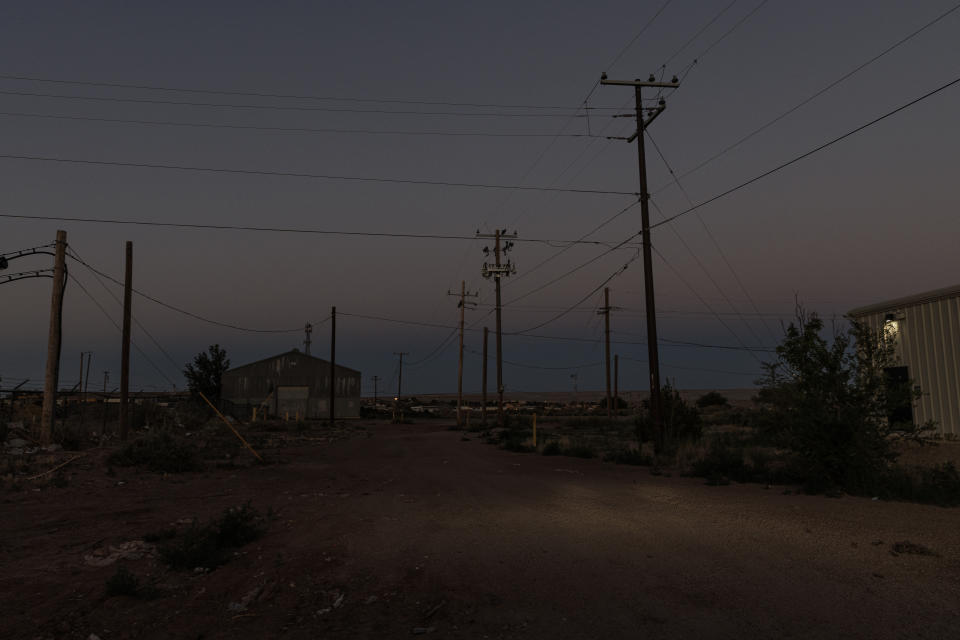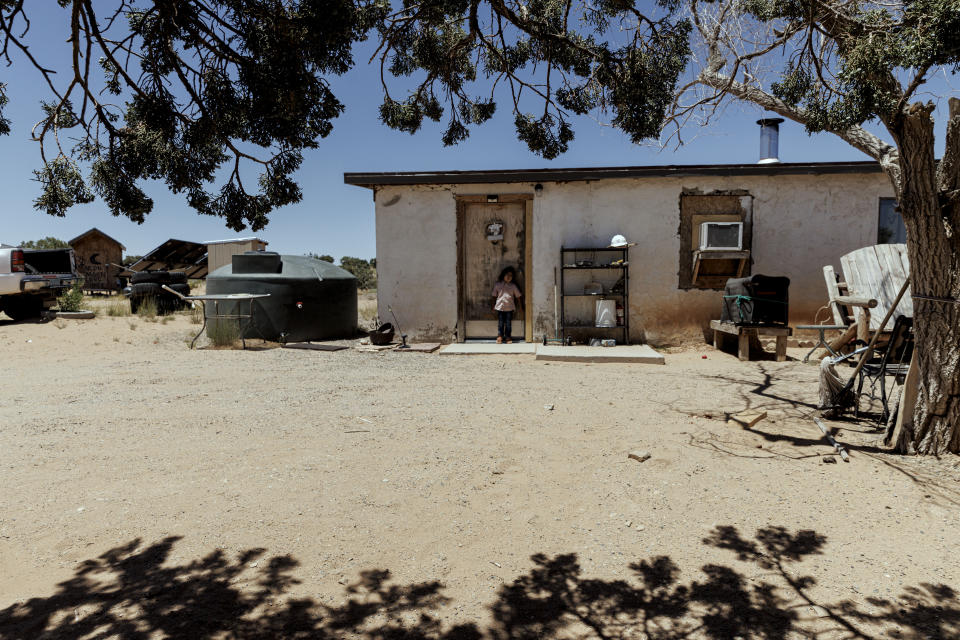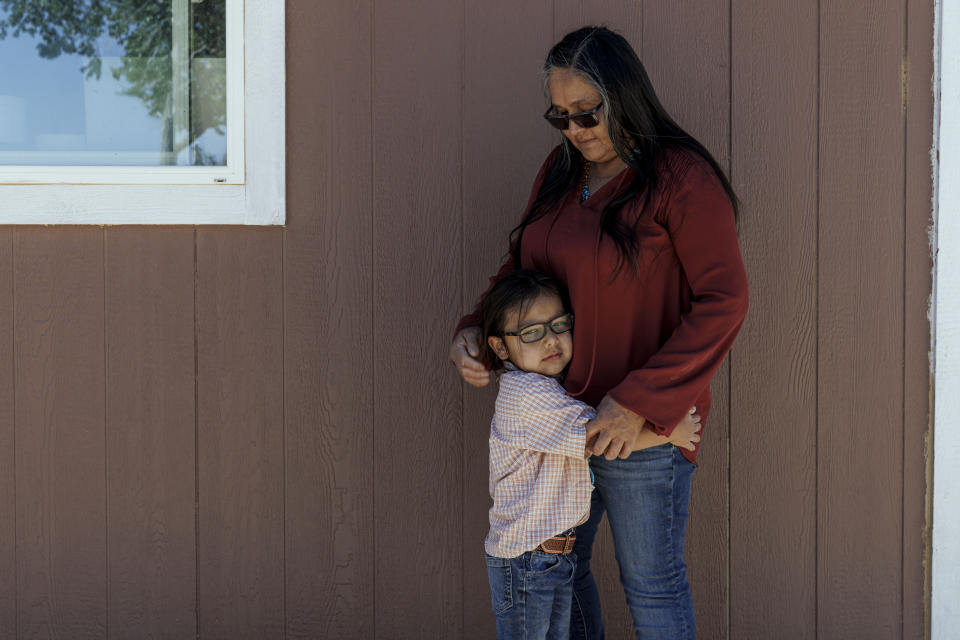This boy was born without an immune system. Gene therapy rebuilt it.
TUBA CITY, Ariz. - Hataałii Tiisyatonii "HT" Begay, a Native American boy who is Diné, or Navajo, rolls toy trucks around in the dirt. He chases chickens into their coop. He pauses to watch his dad deftly gut a sheep for a ceremonial feast. Then he climbs onto a picnic table with his brother and cousins, chanting "Lava!" while pretending the ground has turned into molten rock.
To his family, HT is a typical 5-year-old - a smiling, curious, busy blur who roams across his family's ranch, where the land seems to stretch all the way to the sky.
To his doctors, he is a marvel.
HT was born with a form of severe combined immunodeficiency, or SCID, which meant he had virtually no immune defenses. About 70 children are born with SCID each year in the United States and Canada, though only two or three will have the same type as HT. Without treatment, children with SCID typically die in the first two years of life.
On the sixth day of HT's life, he and his family returned to the hospital where he'd been born in Tuba City, Ariz., a community on the Navajo Nation about 50 miles east of the Grand Canyon. A pediatrician told them HT would need to be isolated and airlifted to Phoenix Children's Hospital. Joy turned to shock. His paternal grandmother, Laverna Shorty, recalls scrubbing her arms down before she could enter the room in Phoenix, which was filled with the sound of HT's coarse cough.
Two and a half months later, at the University of California at San Francisco Benioff Children's Hospital, HT became the first person in the world to receive an experimental gene therapy designed to rebuild his immune system, cell by cell. The outcome of this experiment was far from certain - a big leap of trust for his family, who were relying on Western medicine and traditional knowledge to find a path for HT to come home.
"We just prayed for him," Laverna said. "You know, you overcome things with prayers, and you have to have faith. So I had faith in the Western medicine and my own cultural beliefs."
HT was the trailblazer for a successful gene therapy that has now been given to 13 infants. His recovery highlights the power of treatments that aim to fix the roots of a disease inside a patient's own cells, offering long-lasting outcomes that, doctors hope, may turn out to be cures. It is also one piece of a deeper story about how doctors and families navigated cultural differences and learned from each other to save children's lives.
The next step won't be easy: Drug companies so far have shown little interest in turning HT's experimental therapy into an approved medical treatment. It's a reflection of a broader challenge that threatens to limit the profound potential of gene therapies for ultrarare diseases. But HT's doctors are determined to find a path forward, one that could become a model for other rare conditions to follow.
- - -
Bubble boy disease
SCID is more famously known as "bubble boy disease," after a high-profile case in the 1970s in which a boy in Texas lived to the age of 12 inside a sterile chamber. Today, it is known to be caused by mutations in at least 20 different genes.
Most pediatricians may never see a child with SCID. But during her medical residency at the University of Colorado, Diana Hu cared for a child with SCID from the Navajo Nation who had been sent to Denver for a bone-marrow transplant to treat the condition. In 1985, shortly after she began practicing medicine in Tuba City, she cared for two local babies with SCID. The next year, she saw two more cases.
The alarming number of sick babies spurred doctors to scour medical records and interview families, searching for infants who may have died without being diagnosed. They estimated that among Diné people, 1 in 2,000 babies are born with SCID. In the general population, by contrast, SCID affects about 1 in 58,000 babies.
Karen Yazzie's first child, Brandon Jay Nez, was born in Tuba City in December 1985. He became very sick with diarrhea and pneumonia, and was diagnosed with SCID. He was transported to Denver, but he died in March 1986, before doctors could even try a bone-marrow transplant.
"He never got as far as that," Yazzie said.
Doctors saw that the cases among the Diné followed the pattern of a recessive genetic disease, though they did not yet know which gene caused it. Such illnesses can remain hidden in families for generations, because people carry two copies of each gene, and as long as they have one normal copy, they won't be affected. Children like Brandon were tragically unlucky - they inherited two copies of an errant gene, one from each parent.
Yazzie learned that she and her husband had a 1 in 4 chance of having another child with the illness. Her next child, Brittney Nez, was healthy. In 1990, Yazzie had twins. One of them, Courtney Nez, had SCID.
Hu made a call that was by then becoming familiar, reaching out to Morton Cowan, a pediatric immunologist at the University of California at San Francisco who had become a partner in caring for such patients.
Brittney, then 5, flew out to San Francisco with her mom and baby sister to donate her bone marrow cells to Courtney. In the hospital, Courtney celebrated her first laugh with a traditional Diné ceremony that welcomes the child into the community.
Doctors were beginning to learn that these children didn't always do well, even with a matched bone marrow transplant. Their immune systems didn't always reconstitute, leaving them battling persistent infections, and they were slow to grow, along with other complications.
Courtney was fearless, spunky and strong-willed, Yazzie said. She became partially paralyzed from a stroke around age 10, and later developed bleeding in her lungs. Still, she cooked for her family, making fry bread or a simple breakfast sandwich with toast, eggs and Spam. She bottle-fed lambs. She excelled at school. She never stopped making jokes.
But Courtney was in and out of the hospital her whole life, and she died at age 21.
"There's not a day that goes by that we don't think about her," Brittney said. "See, Court, you're never forgotten, you're always talked about. Everyone remembers you."
- - -
Working together to save children's lives
Over Courtney's short lifetime, doctors began to unravel the disease that haunted these families.
The children lacked T cells and B cells, critical immune fighters that fend off infections. In 2002, Cowan and his colleagues identified a mutation in a gene that codes for a protein called Artemis, which plays a role in DNA repair and is essential for the development of T and B cells; the disease became known as Artemis-deficient SCID. It was more common among people with Diné and Apache ancestry, but it was discovered in other populations, too.
Even with this knowledge, children were still being diagnosed with SCID too late; the first clue often came when babies were in the grip of unusually severe infections.
For decades, routine newborn screening has used a few drops of blood from a baby's heel to test for many genetic disorders. In 2009, a team led by pediatric immunologist Jennifer Puck proposed to pilot a SCID screening test at two hospitals on the Navajo Nation that would analyze an additional drop of blood to help identify SCID at birth. It is now used across the United States.
The progress was possible because Native American families worked with the researchers to find ways to save their children - a partnership that required bridging cultural gaps and mistrust.
"You don't go in there and say, 'I'm going to fix your problem.' You need to be a listener and be humble," Puck said.
Western science and medicine have historically ignored and underestimated the traditional knowledge of Native people, said Katrina Claw, a Navajo geneticist at the University of Colorado's Anschutz Medical Campus. Many people in the community have a deep knowledge of biology and heredity, grounded in expertise in raising livestock and crops passed down over generations. The Navajo clan system, a way of identifying oneself that also keeps track of kinship, is a complex genealogical and cultural system and a form of genetic knowledge, Claw said.
The Navajo Nation implemented a moratorium on genetic research on the reservation in 2002, partially in response to an exploitative history in which researchers retrieved samples or data from Native Americans, often without proper consent or sharing the results. That ugly practice intersects with cultural beliefs that every part of a person's body is sacred, which created concern about what happened to blood or tissue samples after they were taken.
"We're still recovering from this whole helicopter research era, when people took samples and never came back," Claw said. "In my interactions with cultural and tribal leaders, people aren't opposed to cures and treatments. . . . It's the approach and the way it is done that matter to Navajo people."
The doctors in San Francisco began building ties to the reservation in the mid-1980s. Hu helped Cowan organize a picnic in Winslow, Ariz., to meet and interview families to learn their history and gather samples. Over time, that evolved into an annual tradition - a "SCID clinic picnic" where the doctors check up on their patients and then hold a barbecue so the families could share stories, laughter and tears.
- - -
A drop of blood sets off alarm bells
By the time HT was born in April 2018, newborn screening for SCID was routine, and results from his blood test set off immediate alarm bells.
After initial testing in Phoenix, HT was airlifted to San Francisco. A bone-marrow transplant could save HT's life, the doctors told his family, but his older brother, Hastiin, wasn't a match.
There was another option. Cowan and Puck had developed a therapy that could insert a corrected version of the gene that codes for Artemis into stem cells and rebuild the immune system. So far, it had been tested only in cells in a dish and animals. The doctors knew that the prospect of inserting a gene into a baby's stem cells was daunting.
After several lengthy conference calls with HT's parents and grandparents, the family agreed.
The medical team in San Francisco first harvested HT's bone marrow cells. Then, they used a harmless virus to insert the corrected Artemis gene into his cells. And on June 23, 2018, they returned the cells to HT.
His father, Darren Shorty, had been hesitant for his son to join the trial. He went to the family ranch and drew on medicine that he learned from his grandmother, harvesting some traditional healing herbs.
Darren then brought the herb, called "life medicine," to the hospital to make a tea for HT. The care team was unaware of the medicine at first, and Puck tried to intervene, explaining her worry that it would interfere with the gene therapy. Darren explained the healing and spiritual value of the herb, and they reached a compromise. He would make a tea, boiling it for 30 minutes.
Rebuilding an immune system from scratch takes time, and HT's parents had another son to care for, bills to pay and work to do. They went home, and Laverna Shorty, who had already raised nine children and fostered more, quit her job in construction to care for her grandson 24/7 in San Francisco.
Laverna tasted all of HT's medicines before she gave them to him, devising strategies to help him to swallow the bitter ones. She cradled him, counting the raindrops on the window and cars on the street below and singing songs. When she got too tired of holding HT, she fashioned a pouch out of a bedsheet, wrapping HT close to her heart.
Laverna asked the doctors and nurses to explain everything to her. She started looking up immunological terms, learning about T cells, B cells and neutrophils, the immune warriors that protect people from germs.
"I came thinking that I was just going to change diapers, [give] cuddles. No. I actually, I took a big responsibility upon myself," Laverna said.
Everyone rejoiced when, three months after the transplant, a test showed that HT's body had made three T cells per microliter of blood. It was a crucial first step.
Doctors closely monitored HT, watching his immune markers slowly tick up and giving Laverna permission to do things like take him out in a stroller with a plastic protective sheet on top.
HT developed various complications - anemia, infections, mouth sores - and he still needed infusions of antibodies to help shore up his immune system. But when he finally got home, around age 2, he was allowed to play in the dirt and touch an animal, a crucial milestone, because his family keeps horses, dogs, sheep and chickens.
Hu, the Tuba City pediatrician, advocates for these children with a perspective grounded in the decades she has spent caring for the community. Sometimes, that means securing emergency housing for a family if they lack electricity or running water, or finding ways for children to attend school safely despite the risk of an infection.
"People from here have a connection to the land," Hu said. "This is the art of medicine, not the science."
In spring of 2020, HT developed an infection, and he and Laverna were airlifted to San Francisco. The pandemic hit the reservation hard, so they stayed in California for months. When they moved back to the Navajo Nation, they lived in a travel trailer on the family ranch.
Despite the setbacks, HT's immune system was getting stronger. Thirty-two months after his gene therapy, he no longer needed monthly infusions of antibodies.
- - -
Cures in limbo
Cowan and Puck's gene therapy is now a scientific success. Last December, they published a paper in the New England Journal of Medicine showing that 10 infants have been treated, including HT. All were healthy after follow-ups that ranged from 10 months to four years, and four patients no longer needed infusions of antibodies to bolster their immune systems.
At the end of this month, they will treat their 14th patient.
Now, a new challenge looms: how to guarantee other children will be able to access the treatment long term.
Gene therapies for rare diseases can command multimillion-dollar price tags, but even with the potential reward, drug companies' interest so far has been tepid for Artemis-SCID, which afflicts just 2 to 3 percent of the already small number of SCID patients.
In the meantime, many in the field are watching the halting path of a gene therapy called Strimvelis, which is aimed at another form of SCID. The therapy was approved in Europe in 2016.
"That treatment I think you can legitimately say is a cure, and I don't use that word very often," said Philip J. Brooks, the deputy director of the Division of Rare Diseases Research Innovation at the National Center for Advancing Translational Sciences.
But last year, biotechnology company Orchard Therapeutics announced that it would stop its investment in the treatment.
Orchard also stopped development of an experimental treatment for the same type of SCID that had successfully been used in 50 patients, citing manufacturing challenges. Strimvelis has been transferred to an Italian biomedical charity, and Orchard returned the license on the experimental therapy to the academic groups that began the work.
"We've got these transformative, miraculous therapies that don't fit in anyone's business model," said Donald Kohn, a professor of microbiology, immunology and molecular genetics at the University of California at Los Angeles who has been treating patients with the experimental therapy, with dwindling funds. "It's at a paradoxical state. It's hard to get a research grant when you've kind of proven it's effective."
Researchers remain hopeful, and are spitballing new models. A nonprofit might be able to develop such medicines. They're exploring the steps toward setting up commercial manufacturing, looking for alternative funding sources and talking to regulators.
What regulators and scientists agree on is that gene therapies, and eventually gene editing, will provide an opportunity to target thousands of rare diseases - if the manufacturing challenges and business model can be worked out.
"We're at a tender moment for rare-disease gene therapy," said Peter Marks, who leads the center that oversees gene therapies at the Food and Drug Administration.
The urgency comes from seeing children like HT thrive. What's astonishing to Cowan and Puck is how much better the Artemis-SCID gene therapy patients are doing than those who received traditional bone marrow transplants.
The therapy has given these children a way to be children again.
This year, when the doctors came for the SCID clinic and picnic, they got to visit HT at his home - what Puck calls his "place of belonging."
Back at the ranch, Shorty mixed dough in a giant bucket for enough tortillas for 50 people. Her children prepared mutton for a feast. A big pot of potatoes bubbled on the stove.
HT was out there, too, dashing around with the animals or exploring in the shade. After he spent years of living in small spaces, under a constant shadow of worry, his world now stretches as far as the eye can see.
- - -
Dana Hedgpeth contributed to this report.
Related Content
How one rabid kitten triggered intensive effort to contain deadly virus
A lovers' tale of romance, fidelity and the aviary netting keeping them apart
The final hours of Rosalynn Carter's life, in the town where it began














